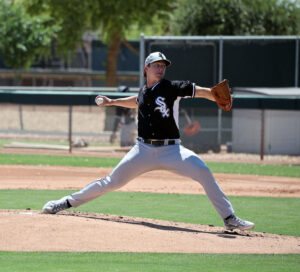How will Gavin Sheets’ power play in the International League?
Despite receiving an over-slot bonus of $2 million from the White Sox to sign as a second-rounder after leading Division I baseball in RBI’s (84) and leading the ACC with 21 home runs in 2017, Gavin Sheets‘ first two seasons as the new left-handed power hitting first baseman in the White Sox organization were not those of your typical corner infield slugger. Even though he did not disappoint in the grand scheme of things, his power output lagged behind a bit. After hitting only 3 home runs in 192 at-bats in Kannapolis in 2017, Sheets slugged only .407 (6 home runs) in 437 at-bats in A(Adv) in 2018, despite putting up 28 doubles and driving in 61.
On the brighter side, Sheets’ excellent eye at the plate pushed his OBP routinely in the .360 range. It was all just a matter of putting things together in Birmingham in 2019. After a swing change that forced the big first baseman to incorporate his legs more, the results were encouraging. Sheets stopped hooking balls foul down the right-field. Instead, more and more of his long fly balls found the area behind the outfield wall in fair territory for homeruns.
In an interview with FutureSox’ Clinton Cole, Sheets talked about the changes he made and the results he experienced. One of the reasons he pointed to, was him being able to find right field more often, while looking to do more damage at the plate. This change in approach and philosophy appeared to work for Sheets. He hit 16 bombs in Double-A in 2019; 10 more than the year before in a similar number of at-bats.
HOW WILL THE POWER PLAY IN AAA?
A succesful season for Sheets meant that he was destined to start the 2020 minor league campaign in Triple-A with the Charlotte Knights. While we’re waiting for baseball to resume (stay home and stay safe, everybody!), it might be a fun excercise to take a look at Sheets’ power potential in the International League. Will it play?
It appears that it should. The question is: why?
First off, Sheets spent 2019 in the Southern League, playing his home games at Regions Field (“where power goes to die”) in Birmingham. The Barons’ home ground measures in at 320 ft in left field, 400 in center, 325 ft in right, and substantial 12 ft walls in left and right. Despite all these factors working against him, Sheets had his best power season of his minor league career. Being a lefty hitter, Sheets’ natural power tendency was to pull the ball to right field, as evidenced by the spray charts below.
The first spray chart displays Sheets’ Minor League career hits. With a mere 1 home run to left field, and 2 to what could be considered center field, it’s clear that Sheets tends to clear the fence in right field by default.

This trend continued in 2019, his most succesful power season of his career. Of his 16 homeruns, 13 were hit to straight away right field, and 3 to right-center, as evidenced by the spray chart below.

NEW HOME FIELD
Taking into consideration that Charlotte’s BB&T Ballpark checks in at 330 ft in left, 400 ft in center and a mere 315 ft in right field (10 ft shorter than Regions Field), Sheets’ move to Triple-A should have a positive outcome based just on ballpark factors alone. Looking at the spray chart above and eye-ball-testing the results, a 315 ft outfield wall would have added at least 8 big flies to Sheets’ 2019 season home run total.
Of course, the Knights have to play away games as well. Taking a quick peek at Sheets’ splits, it seems the slugger has no issues homering away. He hit 7 of his 16 home runs in 2019 in stadiums other than his home ballpark. On top of that, all stadiums within Charlotte’s division have dimensions that should not scare someone like Sheets off.
NOT JUST BALLPARK FACTORS
Of course, Sheets is not strictly reliant on ballpark factors. There is more to a potential breakout in Charlotte. One of the more impressive feats of 2019, was Sheets’ ability to turn his season around at multiple occasions. After a rough start in Birmingham, he quickly found the way back up again, really taking off in late-May. The same thing happened in the Arizona Fall League, where a rough first two weeks eventually led to him being one of the more productive hitters in the AFL. This element of his character should give Sheets the mental tools to deal with the step up to the Minor League’s highest level.
Lastly, there is the aforementioned swing change. Sheets has proved to be open to instruction, succesfully implementing several new elements into his swing. Under the guidance of hitting coach Howie Clark and manager Wes Helms, there is more room for improvement. Gavin Sheets has done nothing to believe he will not be able to continue the trend upwards. If anything, he can position himself in a race with Zack Collins to establish who will be the next left-handed DH in the organization.
Photo credit: Sean Williams/FutureSox






